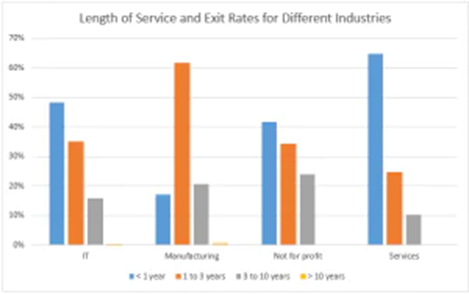Employee retention is always a hot topic for businesses. No one wants to spend time and money recruiting and training new employees, only to have them leave a few months later. While many things companies can do to improve employee retention, using the length of service as a recognition tool is often overlooked. Rewarding long-term employees can help keep them engaged and motivated, reducing the likelihood that they will leave their job. Here’s how you can use a length of service as an employee retention strategy in your business.
What Is Length Of Service?
Length of Service is a metric that calculates the average amount of time an employee has been with a company. This number can help you determine how stable your workforce is, and can be used for comparisons between different teams or age ranges. Additionally, a high length of service generally indicates that an employee is satisfied with their position and is less likely to leave, saving your business the cost of training a replacement.
However, it is important to note that length of service should not be the only metric you use when evaluating your employees – a long tenure does not necessarily mean that an employee is productive or engaged. Instead, look at the length of service in conjunction with other metrics to get a well-rounded view of your workforce.
Why Is It Important For Businesses To Track Their Length Of Service?
For businesses, tracking the length of service is important for a variety of reasons. First, it helps to identify which employees are most likely to stay with the company for the long haul. This is valuable information for succession planning and for making decisions about training and development opportunities.
Secondly, tracking the length of service can help to identify trends in employee retention. This information can be used to make changes to policies and practices that may be contributing to high turnover rates.
Finally, length of service data can be used to reward employees who have been with the company for a significant amount of time. These rewards can help to improve morale and motivation, both of which are essential for business success. In sum, there are many good reasons for businesses to track their length of service data. When used effectively, this data can provide valuable insights into the company’s workforce.
How Do You Calculate Length Of Service?
Length of service is a measure of how long an employee has been with a company. To calculate the length of service, divide the total employment time by the number of employees.
For example, if you have 10 employees who have been with your company for a total of 100 years, your length of service would be 10 years. It’s important to use the same format for the total employment time per employee (e.g. month, years), so that your calculation is accurate.
Length of service is a valuable metric for companies, as it can help to identify long-term employees and track employee retention rates. By understanding length of service, companies can take steps to improve employee satisfaction and loyalty.
Here’s the formula:
Total employment time / Number of employees = Length of service
What Factors Affect Length Of Service?
Length of service is affected by a variety of factors, including the type of job, employer’s policies and expectations, employee performance and work ethic, the availability of alternative employment options for the worker or their family, compensation and benefits offered by the employer, geographic location of the job and lifestyle considerations.
Some employers may require that employees serve a certain minimum length of time in order to qualify for job security or certain long-term benefits. For example, some employers may require a minimum of two years before an employee can be eligible to receive paid vacation days or health insurance coverage.
Geographic location is another factor that can influence length of service. Employees who work in rural areas often have fewer options for alternative employment and may be more likely to stay with an employer for a longer period of time due to the limited options. Similarly, employees in urban areas may have multiple job opportunities and could be more likely to move from job-to-job before making a long-term commitment.
Employee performance can also affect the length of service. Employers often consider an employee’s performance when making decisions about job security and long-term benefits, such as promotions or pay raises. If an employee does not meet expectations or is frequently absent from work, it may lead to a shorter length of service with that employer.
Finally, employees’ personal preferences can also affect the length of service. Some workers may prefer to work in a particular field or with a specific employer, while others might value flexibility and job variety more than security. Depending on an individual’s goals and lifestyle preferences, they may choose to stick with one employer for several years or move from job-to-job more quickly.
Overall, length of service is determined by a variety of factors that are unique to each individual, employer and job. It is important for workers to understand these influences so they can make an informed decision when considering employment opportunities.
Why Is Length Of Service Important?
Length of service is important in the workplace because it can influence job satisfaction, work performance, and employee retention. Longer length of service can provide employees with increased job security and a sense of loyalty from their employer. It also gives them an opportunity to develop deeper relationships with co-workers and supervisors and become more knowledgeable about the organization’s products and processes.
In addition to job security, length of service is important for employers because it can indicate the quality of an employee. It shows that an employee has been successfully working in the organization for a long period of time and may have developed specific skillsets or knowledge about their role. This makes them more qualified, reliable, and productive.
Overall, length of service is an important indicator of job satisfaction and employee loyalty in the workplace. It also provides value to employers as it demonstrates that employees are knowledgeable, reliable, and committed to their roles. Therefore, employers should recognize and reward long-term employees for their dedication and hard work.
What Is A Good Length Of Service?
A good length of service in business is determined by a variety of factors, such as firm size and internal stability. Small, entrepreneurial businesses seeking quick results tend to favour short-term arrangements with staff members since the company’s development cycles may be rapid. On the other hand, larger organizations striving for long-term success may benefit from longer terms of service in order to maximize investments in their personnel.
Small businesses need to acknowledge that employees with lengthy tenure who are familiar with the organization’s objectives and operations can be an invaluable resource over time. Establishing good relationships with employers and supporting them through dedicated service payoffs more than just competitive wages. Ultimately, whether it is beneficial to have a “long” or “short” length of service will depend on what the company needs at any given time.
Examples Of Length Of Service
By analysing the data, grouped into 4 different industry verticals, several variations in lengths of service were observed.
The percentage of exits tracked was 25% for Information Technology (IT), 27% for Manufacturing, 11% for Not For Profit, and 37% for Services.

Interestingly, when compared to the consolidated view, there are some variations. For instance, Manufacturing has the lowest new employee exit in the first year but a much higher exit rate between 1 to 3 years of service. In the services sector, over 65% of new hires quit in the first year, suggesting a difficult work environment or significant increase in career growth and salary opportunities when they switch jobs.
On the other hand, IT and Not-for-Profit organizations have a marked decline in exit rates as the employee tenure increases in the company. This highlights the need for initiatives to retain employees in the first year and make the hiring process more productive.
Strategies To Improve The Length Of Service
Invest in Employee Training and Development Programs:
Investing in employee training and development programs is an effective way to encourage employees to stay with an organization for longer periods of time. By investing in their professional growth, you can create a culture of continuous learning and provide opportunities for employees to develop skills that are valuable to the company.
Offer Flexible Work Schedules:
Offering flexible work schedules allows your team members to have more control over their lives outside of the office. This can be especially beneficial for working parents or those who have other commitments they need to prioritize apart from their job. It also gives them a greater sense of freedom and autonomy, which can help keep morale high and them more likely to stay with the company for a longer period of time.
Provide Good Benefits:
Providing good benefits such as health insurance, retirement plans and paid vacation can show employees that you value and appreciate them. This can make them feel secure in their job and more likely to stay with the company for longer periods of time.
Foster Open Communication:
Encouraging open communication between managers and their teams is key to creating an environment where employees feel comfortable discussing any issues they may have or possible solutions to conflicts. This will help build trust, which is essential for long-term team success and employee retention.
Reward Loyalty:
Rewarding loyalty is one of the best ways to retain top talent for a longer period of time. Recognizing employees for their hard work, dedication and commitment to the company can help show them that you value their contribution and are willing to invest in them. This will likely motivate them to stay with your organization for longer.
Create Opportunities For Advancement:
Offering opportunities for advancement is one of the most effective ways an organization can retain talented team members. Giving people a chance to learn new skills or take on additional responsibilities can help make them feel more invested in their jobs, which could have a positive impact on the length of service.
Offer Competitive Salaries:
Providing competitive salaries is another way companies can encourage longer lengths of service from their employees. People who feel they are being compensated fairly and equally with their peers will be more likely to stay with an organization for longer periods of time.
Create a Positive Work Environment:
Creating a positive work environment is essential for employee retention. Having a culture where respect, openness and collaboration are encouraged can help foster trust between managers and their teams, which can lead to long-term success and higher rates of length of service.
Promote Work/Life Balance:
Encouraging employees to maintain a healthy work/life balance is essential for improving overall productivity and keeping staff satisfied in their jobs. When people feel they have the freedom to pursue personal interests outside of work, they’ll be more likely to stay with an organization for longer periods of time.
Celebrate Success:
Recognizing and celebrating successes is a great way to motivate employees and show them that their efforts are appreciated. This can help create a more positive work environment, which in turn could have an impact on the length of service.
By taking steps such as investing in employee training and providing good benefits, offering flexible work schedules and creating opportunities for advancement, companies can create an environment that encourages employees to stay with the organization for longer periods of time. This could lead to greater team success and higher levels of productivity overall.
Conclusion
Businesses should use length of service as a key performance indicator to help improve employee retention. By offering incentives, such as vacation time, bonuses, and raises, businesses can encourage employees to stay with the company for a longer period of time. Additionally, creating a positive work environment and culture will also help attract and retain employees.

